Look, Ma, No Hands! The AgBot Challenge Showcases the Autonomous Future of Agriculture
Welcome to a world of seeding remotely – if these inventions make it to market.
Look, Ma, No Hands! The AgBot Challenge Showcases the Autonomous Future of Agriculture
Welcome to a world of seeding remotely – if these inventions make it to market.
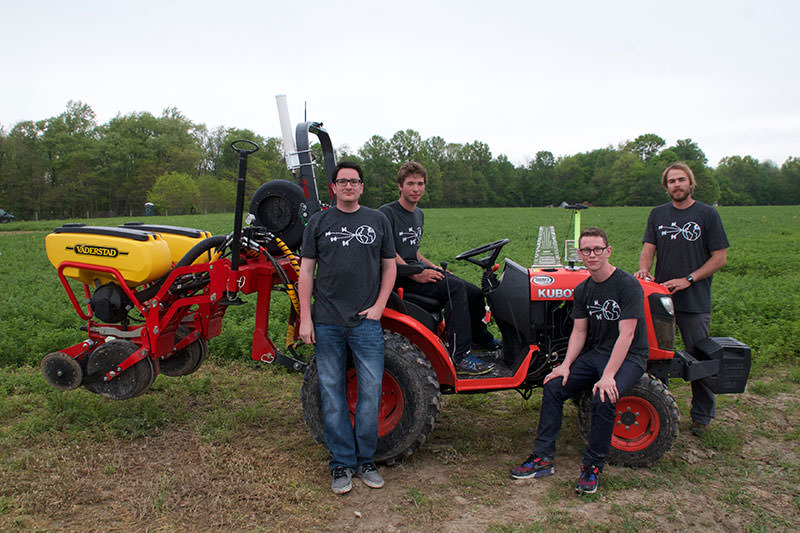
The farming robots we’ll see in the not-too-distant future may look quite a bit like the equipment we already see in the fields – but tricked out with smart, Internet-connected augmentations that allow the machines to operate completely on their own.
That’s our takeaway, at least, from the inaugural AgBot Challenge at Gerrish Farms last weekend, as hundreds of interested people – students, engineers, industry partners, and robotics enthusiasts – descended upon Rockville, Indiana, to watch teams demonstrate their homemade inventions. The specific challenge, which they all chose to accept: develop an unmanned seeding robot that could autonomously plant two seed types in half-mile-long rows, all while being constantly tracked from a remote computer.
This was the first event in a planned three-year series, each one targeting a different farm management need that the student teams and entrepreneurs have to solve. There’s money in it, with cash prizes awarded to the top three teams, but also potential opportunity: with sponsors like Yamaha, AGCO, John Deere, and others in attendance, it’s clear that industry leaders have an eye on what’s coming and could tap into some of that young talent.
Bright Ideas
Speaker Mark Young, chief technology officer of The Climate Corporation, kicked off the event by drawing parallels between the 1960s space race and the current push to bring reliable data and robotics into farming. He suspects that data science will be the norm in agriculture within five years, and believes that young people “have no bias” against it, because, “They’ve never been told that it’s not possible.”
He left some parting words for the competitors, too: “If everything goes right for you today, you probably didn’t try hard enough.”
Everyone must have tried plenty hard, because nearly all the teams encountered setbacks large and small. It’s important to note that these are small groups working with limited resources – but boundless talent, it seems – in a segment of the robotics industry that’s still very new. That teams produced functional prototypes at all seemed an impressive feat.
Ultimately, of the 10 teams entered, just five had robots appear – and only two of those were fully functional and able to complete the task in the fields.
A couple of teams suffered mishaps in the hours leading up to the event. Indiana University – Purdue University Indianapolis had the smallest robot at the Challenge – no larger than a toddler’s tricycle – and it was envisioned as part of a team of robots that could patrol a farmer’s fields and relay data. However, the controller blew the night before, leaving them with no way to guide its movements.
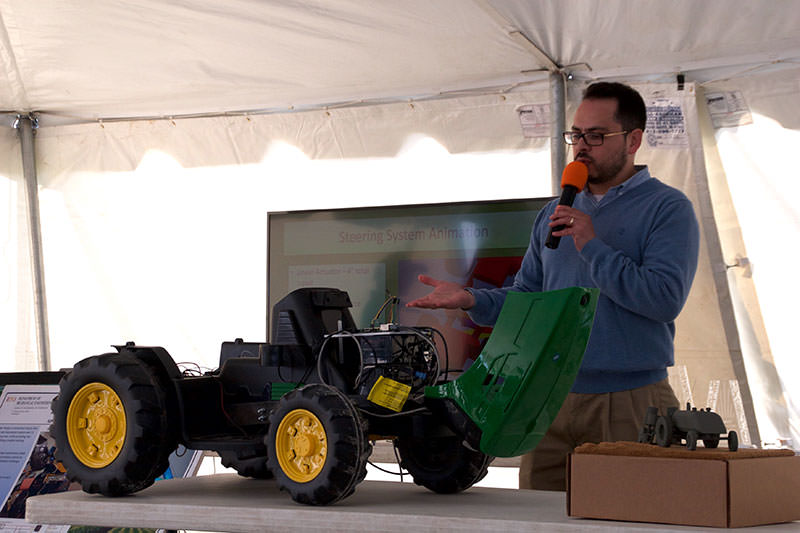
Another non-functional prototype came from engineer Nathan Muchowski, who came down from Muchowski Farms up in Odessa, Saskatchewan, Canada. His robot, an automated hybrid electric cart, was self-built and programmed within the last few months – but the design, which put the wheels inside of the frame, helped lead to a broken axle the night before the event. Still, Muchowski’s concept resonated with judges and tied for third place with another team, Pee Dee Precision from South Carolina, and will share the $20,000 prize.
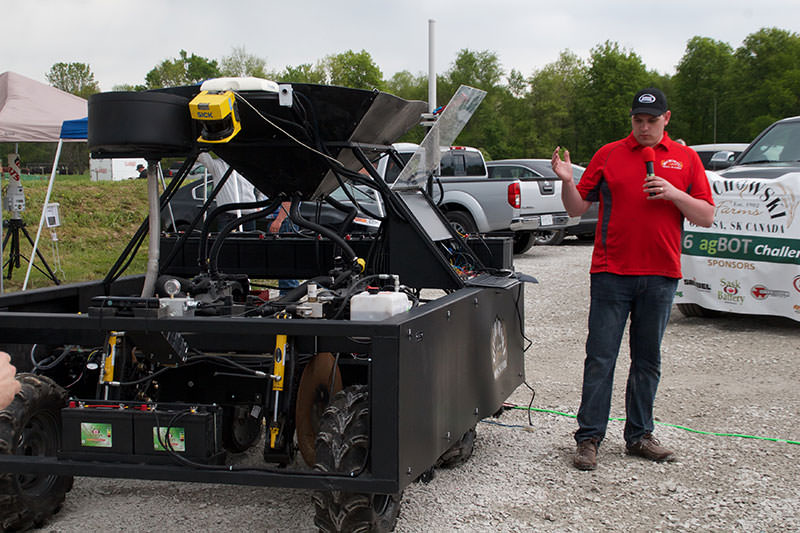
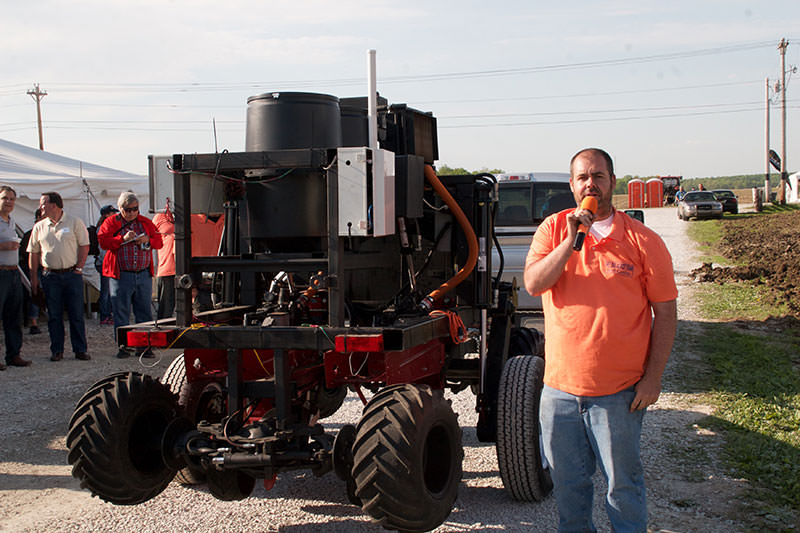
Real Results
Luckily, the two teams with working agbots impressed both judges and attendees alike. Purdue University’s team won the second-place $30,000 prize with the largest solution on hand: a loader modified and augmented with connected technology. Loads of cables and even a common home router were visible from the open cab door, and when set out into the fields, the loader completed the job and provided remote camera views to the operator via computer.
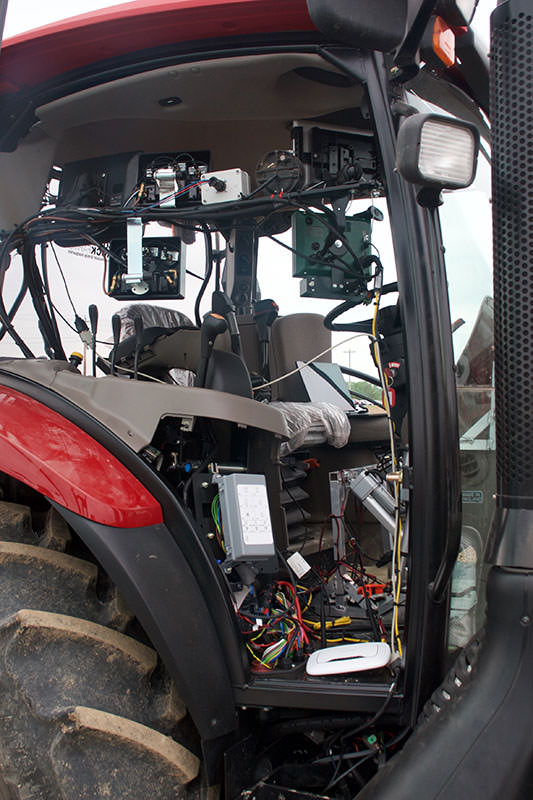
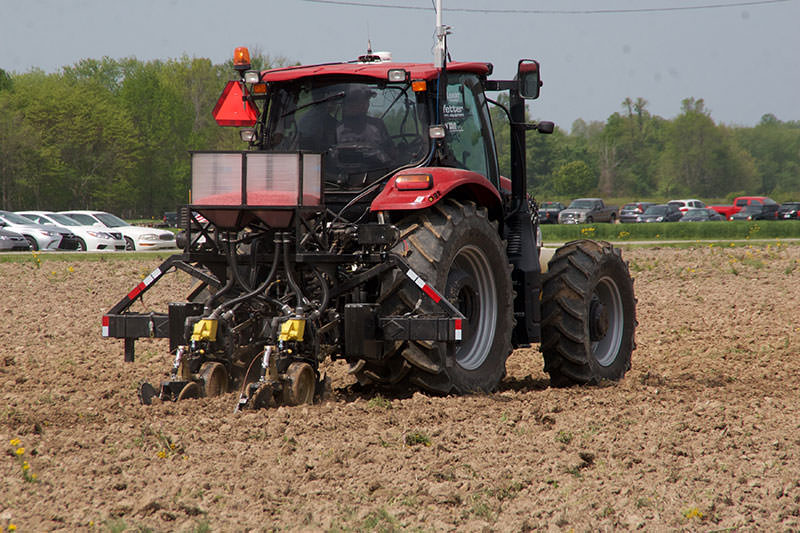
The project was a collaboration between Purdue Agriculture and students from South Newton high school in Kentland, Indiana, and the team suggested that its setup would allow farmers to be “proactive instead of reactive on a daily basis.” Benefits would include increased productivity and 24/7 farming capabilities with only one operator overseeing multiple robots from afar, as well as seed and inventory tracking capabilities.
Any three-point loader attachment could work with Purdue’s machine, and the team planned to expand the number of rows it could simultaneously plant following the event.
Ultimately, the winning invention came all the way from the University of Regina in Saskatchewan, Canada, as a trio of industrial systems engineering students – with help from an alumnus – turned their capstone project into an AgBot Challenge victory. Like other teams, the Regina squad had some issues to contend with: After their robot made its way into the field, the communication link between it and the laptop failed, and movement stopped for a couple minutes as bystanders anxiously awaited.
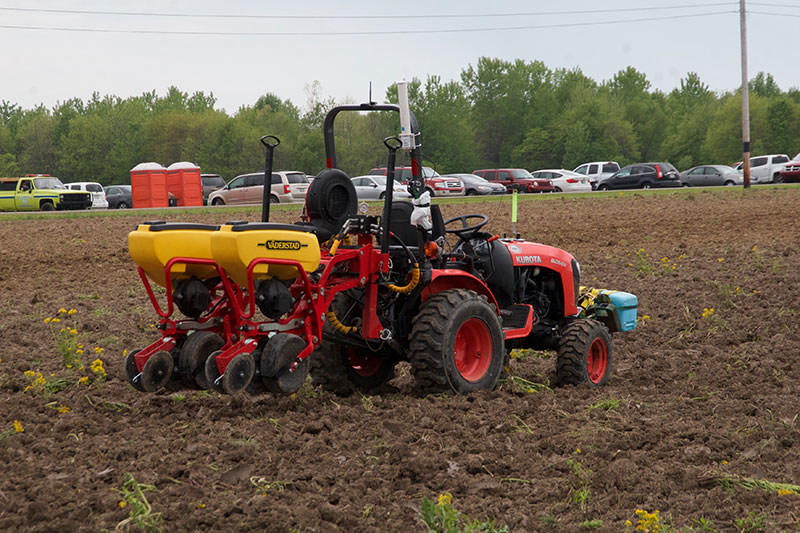
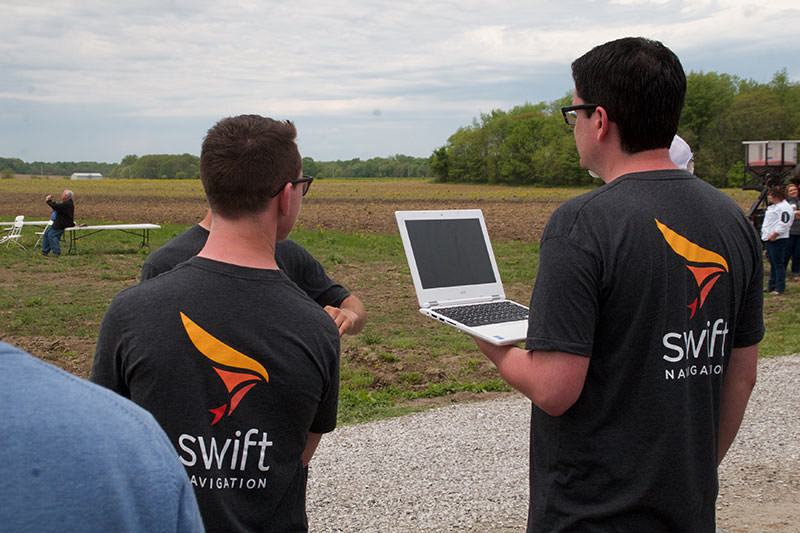
It was only a temporary hurdle, however, and the modified tractor completed several rows of seed planting in the field without human control or even a person onboard. What really seemed to impress attendees was the accuracy of its movements and the polished remote user interface, which used GPS coordinates and map overlays to show the robot’s movements. The path it followed was nearly perfectly matched up with the projection.
The team – comprised of students Sam Dietrich with Caleb and Joshua Friedrick, along with civil engineering technologist Dean Kentai – was praised for its round-the-clock work ethic in the days leading up to the event. In fact, the members couldn’t be found at the start of the awards ceremony, as they were off tinkering with the robot again. That hard work and the long nights paid off as the team won $50,000 with the top prize.
Another Round Ahead
It might be years before more polished, professional autonomous robots are roaming America’s fields, but the event aims to, ahem, plant the seeds in the young, creative minds that could ultimately drive that revolution.
Next year, the AgBot Challenge will turn its attention towards weed and pest identification and removal; challenge specifications will be released on May 23. And in 2018, the Challenge will focus on autonomous harvesting. All told, the three-year plan hopes to produce a wide array of concepts to help realize future of agriculture robotics.
Given the enthusiasm around this year’s showdown, the organizers have decided to extend the seeding phase of the competition into 2017, as well. That will allow teams to learn from this year’s successes and missteps alike, and further develop the technology for another 12 months – and the overseers expect that interest will skyrocket after this first stage, bringing even more teams and industry observers into the fray.
“I do see this growing quite rapidly,” admits Rachel Gerrish, director of operations at AirBridge, which provided the mobile tracking antennas. “I hope and also see a lot of people in the ag industry starting to embrace robotics.”
Follow us
This work is licensed under a Creative Commons Attribution-NoDerivatives 4.0 International License.
Want to republish a Modern Farmer story?
We are happy for Modern Farmer stories to be shared, and encourage you to republish our articles for your audience. When doing so, we ask that you follow these guidelines:
Please credit us and our writers
For the author byline, please use “Author Name, Modern Farmer.” At the top of our stories, if on the web, please include this text and link: “This story was originally published by Modern Farmer.”
Please make sure to include a link back to either our home page or the article URL.
At the bottom of the story, please include the following text:
“Modern Farmer is a nonprofit initiative dedicated to raising awareness and catalyzing action at the intersection of food, agriculture, and society. Read more at <link>Modern Farmer</link>.”
Use our widget
We’d like to be able to track our stories, so we ask that if you republish our content, you do so using our widget (located on the left hand side of the article). The HTML code has a built-in tracker that tells us the data and domain where the story was published, as well as view counts.
Check the image requirements
It’s your responsibility to confirm you're licensed to republish images in our articles. Some images, such as those from commercial providers, don't allow their images to be republished without permission or payment. Copyright terms are generally listed in the image caption and attribution. You are welcome to omit our images or substitute with your own. Charts and interactive graphics follow the same rules.
Don’t change too much. Or, ask us first.
Articles must be republished in their entirety. It’s okay to change references to time (“today” to “yesterday”) or location (“Iowa City, IA” to “here”). But please keep everything else the same.
If you feel strongly that a more material edit needs to be made, get in touch with us at [email protected]. We’re happy to discuss it with the original author, but we must have prior approval for changes before publication.
Special cases
Extracts. You may run the first few lines or paragraphs of the article and then say: “Read the full article at Modern Farmer” with a link back to the original article.
Quotes. You may quote authors provided you include a link back to the article URL.
Translations. These require writer approval. To inquire about translation of a Modern Farmer article, contact us at [email protected]
Signed consent / copyright release forms. These are not required, provided you are following these guidelines.
Print. Articles can be republished in print under these same rules, with the exception that you do not need to include the links.
Tag us
When sharing the story on social media, please tag us using the following: - Twitter (@ModFarm) - Facebook (@ModernFarmerMedia) - Instagram (@modfarm)
Use our content respectfully
Modern Farmer is a nonprofit and as such we share our content for free and in good faith in order to reach new audiences. Respectfully,
No selling ads against our stories. It’s okay to put our stories on pages with ads.
Don’t republish our material wholesale, or automatically; you need to select stories to be republished individually.
You have no rights to sell, license, syndicate, or otherwise represent yourself as the authorized owner of our material to any third parties. This means that you cannot actively publish or submit our work for syndication to third party platforms or apps like Apple News or Google News. We understand that publishers cannot fully control when certain third parties automatically summarize or crawl content from publishers’ own sites.
Keep in touch
We want to hear from you if you love Modern Farmer content, have a collaboration idea, or anything else to share. As a nonprofit outlet, we work in service of our community and are always open to comments, feedback, and ideas. Contact us at [email protected].by Andrew Hayward, Modern Farmer
May 12, 2016
Modern Farmer Weekly
Solutions Hub
Innovations, ideas and inspiration. Actionable solutions for a resilient food system.
ExploreExplore other topics
Share With Us
We want to hear from Modern Farmer readers who have thoughtful commentary, actionable solutions, or helpful ideas to share.
SubmitNecessary cookies are absolutely essential for the website to function properly. This category only includes cookies that ensures basic functionalities and security features of the website. These cookies do not store any personal information.
Any cookies that may not be particularly necessary for the website to function and are used specifically to collect user personal data via analytics, ads, other embedded contents are termed as non-necessary cookies.